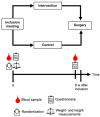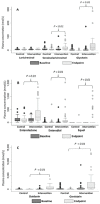Effects on Serum Hormone Concentrations after a Dietary Phytoestrogen Intervention in Patients with Prostate Cancer: A Randomized Controlled Trial
- PMID: 37049632
- PMCID: PMC10097251
- DOI: 10.3390/nu15071792
Effects on Serum Hormone Concentrations after a Dietary Phytoestrogen Intervention in Patients with Prostate Cancer: A Randomized Controlled Trial
Abstract
Phytoestrogens have been suggested to have an anti-proliferative role in prostate cancer, potentially by acting through estrogen receptor beta (ERβ) and modulating several hormones. We primarily aimed to investigate the effect of a phytoestrogen intervention on hormone concentrations in blood depending on the ERβ genotype. Patients with low and intermediate-risk prostate cancer, scheduled for radical prostatectomy, were randomized to an intervention group provided with soybeans and flaxseeds (∼200 mg phytoestrogens/d) added to their diet until their surgery, or a control group that was not provided with any food items. Both groups received official dietary recommendations. Blood samples were collected at baseline and endpoint and blood concentrations of different hormones and phytoestrogens were analyzed. The phytoestrogen-rich diet did not affect serum concentrations of testosterone, insulin-like growth factor 1, or sex hormone-binding globulin (SHBG). However, we found a trend of decreased risk of increased serum concentration of estradiol in the intervention group compared to the control group but only in a specific genotype of ERβ (p = 0.058). In conclusion, a high daily intake of phytoestrogen-rich foods has no major effect on hormone concentrations but may lower the concentration of estradiol in patients with prostate cancer with a specific genetic upset of ERβ.
Keywords: estradiol; insulin-like growth factor 1; isoflavones; lignans; phytoestrogens; prostate cancer; sex hormone-binding globulin; testosterone.
Conflict of interest statement
The authors declare no conflict of interest. The funders had no role in the design of the study; in the collection, analyses, or interpretation of data; in the writing of the manuscript; or in the decision to publish the results.
Figures




Similar articles
-
The effect of a phytoestrogen intervention and impact of genetic factors on tumor proliferation markers among Swedish patients with prostate cancer: study protocol for the randomized controlled PRODICA trial.Trials. 2022 Dec 21;23(1):1041. doi: 10.1186/s13063-022-06995-2. Trials. 2022. PMID: 36544211 Free PMC article.
-
Dietary soy-phytoestrogens decrease testosterone levels and prostate weight without altering LH, prostate 5alpha-reductase or testicular steroidogenic acute regulatory peptide levels in adult male Sprague-Dawley rats.J Endocrinol. 2001 Sep;170(3):591-9. doi: 10.1677/joe.0.1700591. J Endocrinol. 2001. PMID: 11524239
-
Effects of a Phytoestrogen Intervention and Estrogen Receptor β Genotype on Prostate Cancer Proliferation and PSA Concentrations-A Randomized Controlled Trial.Nutr Cancer. 2024 Sep 28:1-15. doi: 10.1080/01635581.2024.2407007. Online ahead of print. Nutr Cancer. 2024. PMID: 39340410
-
Effect of dietary components, including lignans and phytoestrogens, on enterohepatic circulation and liver metabolism of estrogens and on sex hormone binding globulin (SHBG).J Steroid Biochem. 1987;27(4-6):1135-44. doi: 10.1016/0022-4731(87)90200-7. J Steroid Biochem. 1987. PMID: 2826899 Review.
-
Effects of Dietary Phytoestrogens on Hormones throughout a Human Lifespan: A Review.Nutrients. 2020 Aug 15;12(8):2456. doi: 10.3390/nu12082456. Nutrients. 2020. PMID: 32824177 Free PMC article. Review.
References
-
- De Nunzio C., Lombardo R., Albisinni S., Gacci M., Tubaro A. Serum levels of Sex Hormone Binding Globulin (SHBG) are not predictive of prostate cancer diagnosis and aggressiveness: Results from an italian biopsy cohort. Int. Braz. J. Urol. 2013;39:793–799. doi: 10.1590/S1677-5538.IBJU.2013.06.04. - DOI - PubMed
Publication types
MeSH terms
Substances
Grants and funding
- ALFGBG-727821, ALFGBG-966360/LUA/ALF agreement in the West of Sweden health care region
- 2021:353, 2020:320, 2019:262, 2018:206, 2017:145, 2016:76/King Gustav V Jubilee Clinic Research Foundation at Sahlgrenska University Hospital
- Maria Hedelin 2014/Dr.P.Håkansson's Foundation, Eslöv, Sweden
- Maria Hedelin/Patientföreningen för prostatacancer ProLiv Väst
- 2013;10/Lions Cancerfond Väst
LinkOut - more resources
Full Text Sources
Medical
Miscellaneous

